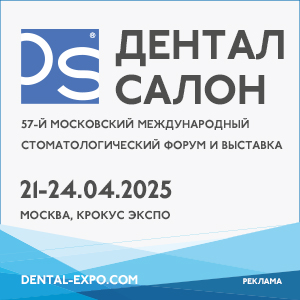DOI:
10.37988/1811-153X_2022_3_20To assess the stability and osseointegration of dental endosseous-subperiosteal implant with a through porosity in the conditions of atrophy of the bone tissue using the apparatus Periotest S
Downloads
Abstract
One of the more significant criteria for successful and long-term functioning of dental implants is considered to be stability, expressed in the process of osseointegration in the postoperative period and at further stages of functioning. The issues that arise when determining the level of primary stability of implants in bone tissue and the time of the start of active loading of implants have not yet been fully resolved. In this regard, an objective assessment of the level of stability of dental implants plays an important role in choosing the shape of the implant, the timing of the start of the orthopedic stage, predicting the quality of orthopedic rehabilitation. The aim of the work is to study the effectiveness of the use of dental implants with through porosity in the treatment of patients with partial absence of teeth and bone atrophy. . The study included patients with partial absence of teeth, who were fitted with 81 dental intraosseous-bone implants of the author’s design, with a sleeve made of non-woven titanium material with through porosity. The stability of the implants after 1, 2, 4, 6 and 12 months after installation was evaluated clinically, radiologically and by measurements of the Periotest S device. . According to Periotest, good stability of integrated dental intraosseous implants with through porosity was achieved. The average value of the Periotest decreased (improved) to -2.81±0.12 6 months after implantation, and to -3.83±0.11 1 year after the functioning of the implants. The dependence of the stability of functioning implants on the values of primary stability was revealed. . The Periotest device allows you to get information about the state of the bone tissue around the implants, the level of stability of the implant, to determine the characteristic signs of disintegration of the implants. According to these data, it is possible to predict the results of orthopedic treatment of patients using dental implants in conditions of bone atrophy.Key words:
dental intraosseous implant with through porosity, osseointegration, stability, PeriotestFor Citation
[1]
Bayrikov I.M., Monakov D.V., Monakov V.A., Samutkina M.G., Rudak K.D. To assess the stability and osseointegration of dental endosseous-subperiosteal implant with a through porosity in the conditions of atrophy of the bone tissue using the apparatus Periotest S. Clinical Dentistry (Russia). 2022; 25 (3): 20—24. DOI: 10.37988/1811-153X_2022_3_20
References
- Durnovo E.A., Bespalova N.A., Andreeva M.V., Korsakova A.I. Modern view on the problem of aesthetic rehabilitation of patients using dental implants. Modern Problems of Science and Education. 2017; 5: 65 (In Russ.). eLIBRARY ID: 30457868
- Kulakov A.A., Grebnev G.A., Brailovskaya T.V., Bagnenko A.S., Ilyin S.V., Ishniyazova A.I. Long-term results of dental implantation in military personnel. Stomatology. 2022; 2: 31—35 (In Russ.). eLIBRARY ID: 48239903
- Kulakov A.A., Badaljan V.A., Apojan A.A., Elfimova N.V., Stepanjan Z.M. Experience of using the technique of preserving the volume of the alveolar bone by using a fragment of the removed tooth to close the alveolar socket in a patient with chronic apical periodontitis. Clinical Dentistry (Russia). 2018; 4 (88): 22—25 (In Russ.). eLIBRARY ID: 36517609
- Kulakov A.A., Gvetadze R.Sh., Brailovskaya T.V., Khar’kova A.A., Dzikovitskaya L.S. Modern approaches to dental implants placement in deficient alveolar bone. Stomatology. 2017; 1: 43—45 (In Russ.). eLIBRARY ID: 28795332
- Zhou X., Yang J., Wu L., Tang X., Mou Y., Sun W., Hu Q., Xie S. Evaluation of the effect of implants placed in preserved sockets versus fresh sockets on tissue preservation and esthetics: A meta-analysis and systematic review. J Evid Based Dent Pract. 2019; 19 (4): 101336. PMID: 31843184
- Bayrikov I.M., Slesarev O.V., Ovchinnikov P.A., Tyumina O.V., Volchkov S.E., Malchikova D.V., Bugakov A.I. Guided regeneration of facial cranial bone tissue. Russian Journal of Transplantology and Artificial Organs. 2020; S: 129 (In Russ.). eLIBRARY ID: 44018734
- Chrcanovic B.R., Kisch J., Albrektsson T., Wennerberg A. Analysis of risk factors for cluster behavior of dental implant failures. Clin Implant Dent Relat Res. 2017; 19 (4): 632—642. PMID: 28332286
- da Rosa J.C.M., Pértile de Oliveira Rosa A.C., Huwais S. Use of the immediate dentoalveolar restoration technique combined with osseodensification in periodontally compromised extraction sites. Int J Periodontics Restorative Dent. 2019; 39 (4): 527—534. PMID: 31226191
- Volkov A.V., Smbatyan B.S., Nazaryan D.N., Muraev A.A. A Novel morphometric nomenclature to evaluate osseointegration of intraosseous implants. Modern Technologies in Medicine. 2018; 3: 7—13 (In Russ.). eLIBRARY ID: 36297429
- Panahov N.A., Mahmudov T.G. The stability level of dental implants in different periods of functioning. Actual Problems in Dentistry. 2018; 1: 89—93 (In Russ.). eLIBRARY ID: 32840697
Downloads
Received
June 28, 2022
Accepted
August 11, 2022
Published on
October 30, 2022











